SMS Engagement for Shopping Brands in Europe and North America
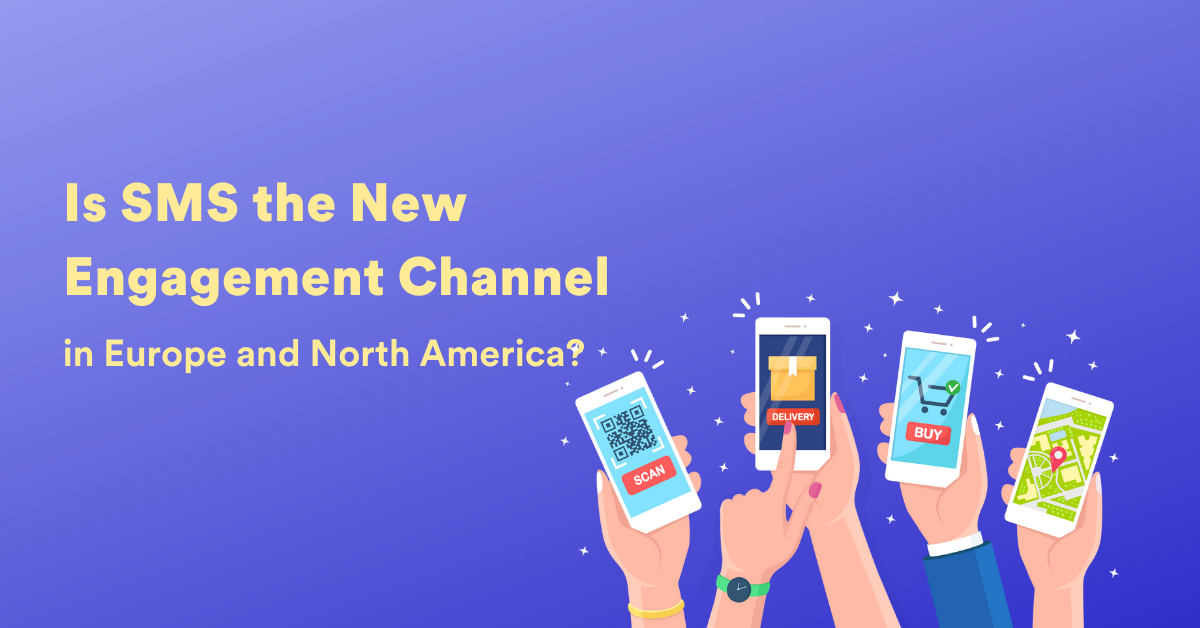
Reading Time: 7 minutes
Receiving DMs or SMS directly in your inbox has a deeper impact than following social posts. Public posts, promotions, or ads have a limited reach. They are optional in terms of consumption. But a personalized message is direct and specific. And out of all the communication channels – social media, SMS, and Email – SMS engagement is one of the most effective ones with 3x higher usage than Facebook.
Since SMS are a direct mode of messaging, you need to be very careful about using this channel for customer engagement lest it backfires. So formulating a proper strategy for content, frequency, and timing to engage customers will work for brands. Engagement strategies evolve according to consumer behavior, and each channel has its own set of rules to drive engagement. What holds good for Email may not be accurate for SMS. That’s why SMS is the most followed engagement channel, and with the right strategy in place, you can drive tremendous results.
SMS trends in Europe and North America
SMS as an engagement channel is taking heat in the European and North American regions. Mobile phones have become an extension of modern life with a constant connection to the outer world. You would be surprised to know how many times an average customer checks their mobile in a day; it is 160 times. No wonder the SMS open rate is 98%.
Even though the new generation widely adopts Facebook Messenger, 80% of customers in the US still prefer SMS texting over it. The reason is quite apparent – early mover advantage. Customers are so used to this channel that almost half of the shoppers don’t even hesitate to share their phone numbers while shopping.
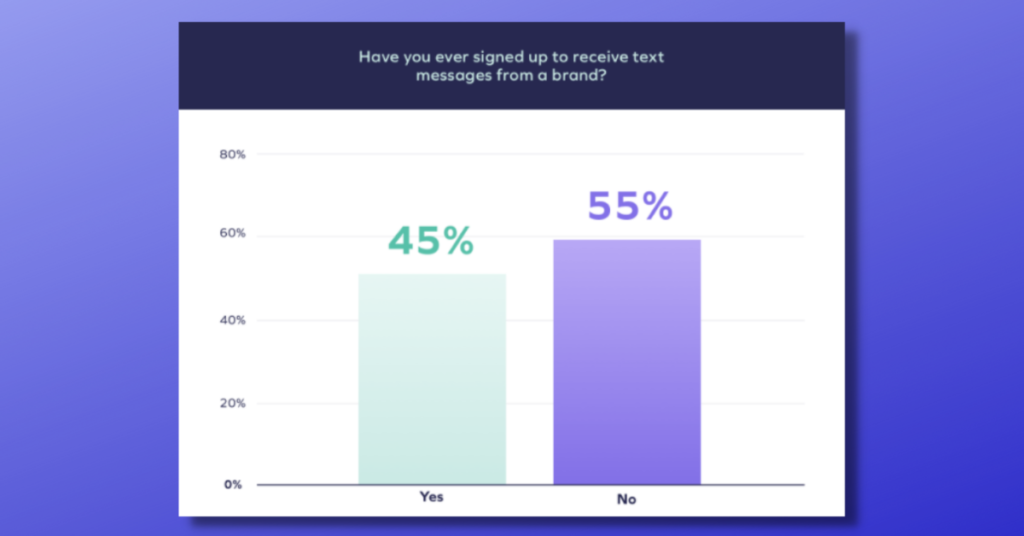
They are not just open to receiving promotional content, but 51% of customers prefer getting tracking and delivery information of their orders. Tracking info is the most effective means to keep the customers from anxiety about their online orders, should there be any delay. It helps brands stay accountable to the customers in every step of the delivery.
While new customers are always good to have, repeat customers are the most valuable asset for a brand. The good news for North American and European brands is that a staggering rate of 37% of customers prefer to get new product announcements over SMS. In comparison, 20% prefer to get product recommendations based on their purchase patterns.
SMS Engagement for Retail and E-commerce
Retail and E-commerce are some of the most widely consumed sectors. Consumers want instant updates on their orders, and there’s no better channel than SMS for that. Instead of using customer calls, texting makes it much simpler to keep the customers informed. And when a message is directed to a number of people, bulk SMS is the most effective method. It also helps businesses reduce the overhead of maintaining customer care by easily automating their workflows to trigger messages through online events.
Three ways to engage customers through SMS are:
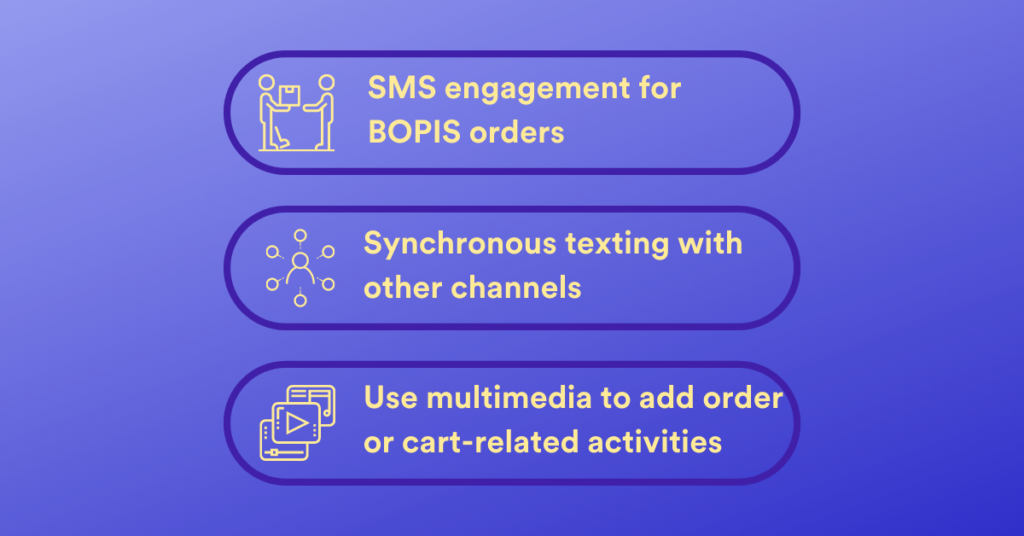
SMS engagement for BOPIS orders
Apart from the online delivery system, BOPIS (Buy Online, Pick-up in Store) is one of the fastest-growing sales approaches. It allows customers to pick up orders conveniently instead of depending on the seller’s scheduled time. Retailers widely adopt BOPIS, and 90% of retailers plan to offer this option by the end of the year 2021.
To make it simple, SMS engagement during BOPIS orders is done in four stages:
Order confirmation
Allowing anonymous customers to purchase online makes it challenging to personalize their experience. You would want to keep them engaged in their entire purchase journey, for which there are two options:
- Mobile wallet pass
- Online apps
You can create customer identity through both options and send them personalized messages.
Pre-pickup
You can arrange a live chat or send them a push notification when you know the customer is nearing the store through a live location. Sending them advanced notifications and instructions could expedite the process.
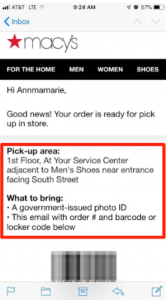
On-premise
This is the stage when the customer is physically and mentally present in your business territory. Hence, you must leverage their attention to boost engagement by sending them relevant SMS requests like app downloads, loyalty programs, or special offers.
Post-pickup
The post pickup stage is where you would want them to become your repeat customers. Hence, sending messages to cross-sell, upsell, or gather customer sentiments is the best time.
Synchronous texting with other channels
A customer journey starts much earlier than when they visit your E-commerce website or app. It usually begins with engaging them on social media to address their initial queries. You must send them a relevant engagement message based on their current stage to gauge their social media activities like comments, shares, or likes.
Immediate actions like login failure or account lock can be followed by a phone call from your customer care, while the confirmation messages can be sent through SMS. Abandoned orders can be retargeted with SMS engagement too. Helpful reminders for such transactions must be sent at the right time.
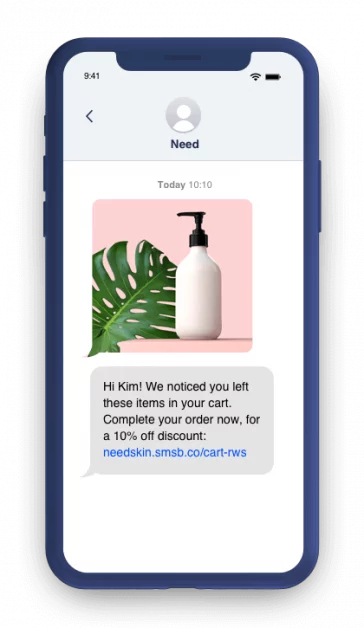
Search engine ads are another channel you must leverage to boost customer engagement in conjunction with well-timed SMS. After they visit your landing page and become inactive, you can send them messages with special offers and discounts.
You must maintain the right balance between being intrusive and engaging effectively to drive better outcomes through SMS. Sending messages at every touchpoint might backfire. Avoid using SMS engagement for already active customers lest they consider it spammy.
Use multimedia to add order or cart-related activities
SMS can be as creative as messages in your chat messengers. Using multimedia, you can send messages with item images that they showed interest in buying. Giving them a clickable link in the same message would allow you to direct them to your E-commerce website. This way, your MMS becomes another channel to direct traffic to your online shop.
You can send eye-catching promotions, low-season discounts, and special deals using multimedia. Promoting such deals in plain text doesn’t impact until you have creatives in the message. Hence, images or GIFs can enhance the customer experience and boost their engagement with your brand.
Why Choose SMS as a Channel
Being the earliest channel among all, the wide adoption of SMS as a mode of communication is a no-brainer. Undoubtedly, with so many different channels popping up now and then, SMS still holds its place among the top engagement channels. A few reasons for that are:
Default messaging app
Even the feature phones have SMS functionality pre-installed in them. Hence, it makes it the most adopted channel even for a layman. When customers purchase a smartphone, installing other messengers like Facebook, WhatsApp is still optional. But SMS is present by default.
Faster read time
SMS is one of the fastest means to communicate. Recent research states that an SMS is opened within the first 3 minutes of receiving. Furthermore, push notifications have made the task even more agile for mobile users to get to the messages without unlocking their phones.
No dependency on the internet
Owing to the lowest byte size, around 140 bytes, it is too easy to send and receive SMS over other signaling protocols. Hence, no internet usage makes SMS even more simple communication channel. Mobile towers are often more expansive than 5G towers. Therefore, SMS has the maximum reach even to the remotest parts of the world.
Customer approval
Customers have the least friction while using SMS as a channel to engage. Compared to emails that are quite long or phone calls being more intrusive, customers are most comfortable reading SMS due to its optimum balance. And because of its adoption in the early days, customers still hold an affinity towards this channel more than others.
Sending Dynamic Content using SMS Engagement
Using dynamic content is one of the most valuable tactics to hyper-personalize your SMS engagement. It allows you to include customers’ personal and buying info to make an SMS more relevant.
Personalization is usually implemented for the following fields:
- Message title, body, and summary;
- Multimedia, i.e., images and coupons; and
- Deep-link URLs.
Based on customer actions, send personalized messages for specific events, e.g., when a customer views the product, abandons a cart, or when the brand offers special deals.
With an SMS engagement tool like MoEngage, you can pre-select the Message title with customer attributes as shown below:
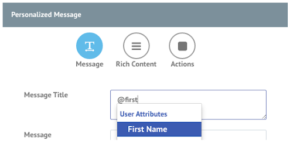
For the body of the message, populate the product’s name as a variable based on the customer behavior.
Likewise, populate images as shown below:
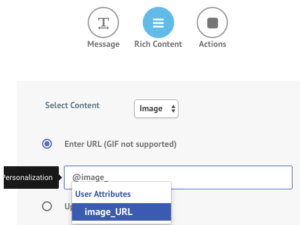
This is especially helpful to remind the customer about the product they viewed or abandoned in the cart.
Your SMS engagement can go down in flames if personalization fails and the message goes out to the customer. Hence, set up a default message advance for such cases. This is where you can do that:
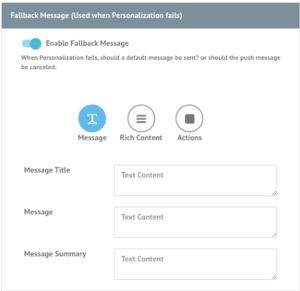
Doing SMS Engagement Right
At first glance, SMS engagement may seem outdated when compared to flashy messengers of recent times, but the research says it is still the most widely used channel for customer engagement.
Although the channel remains the same, the use cases are evolving. Businesses are getting more sensitive towards customer behavior and hence are learning to leverage SMS engagement accordingly to its best.
SMS was the past and present and will hold its place in the future. Using it creatively with an optimum balance between being spammy and useful can set you apart from the rest of the brands.
What to do next
1. Learn how 6 global brands are successfully leveraging SMS marketing using an insights-led engagement approach
2. Choose between push notification and SMS — understand both as engagement channels’ comparison and performance metrics.
3. Learn what SMS engagement entails and how brands can grow their business with its help.













